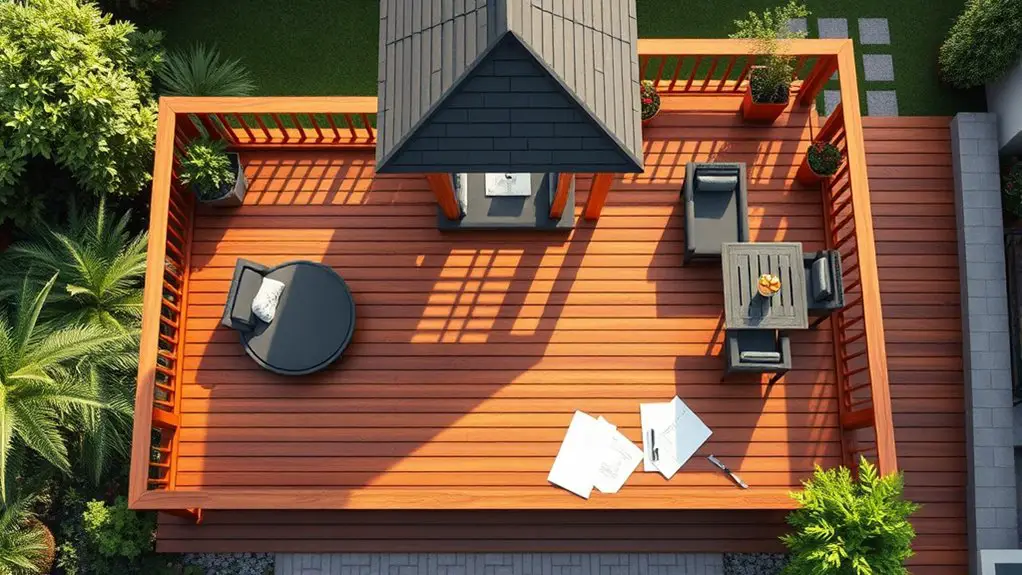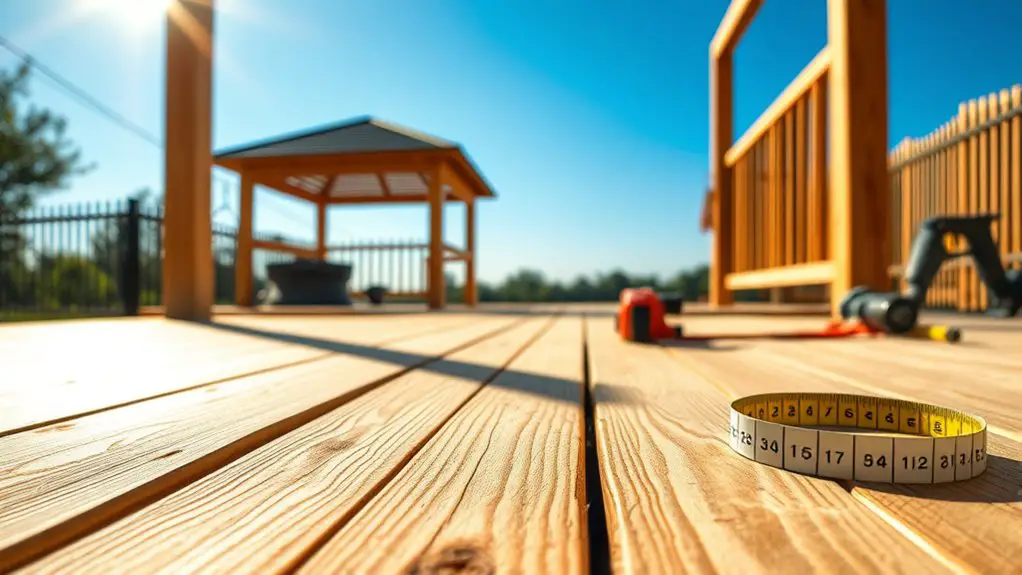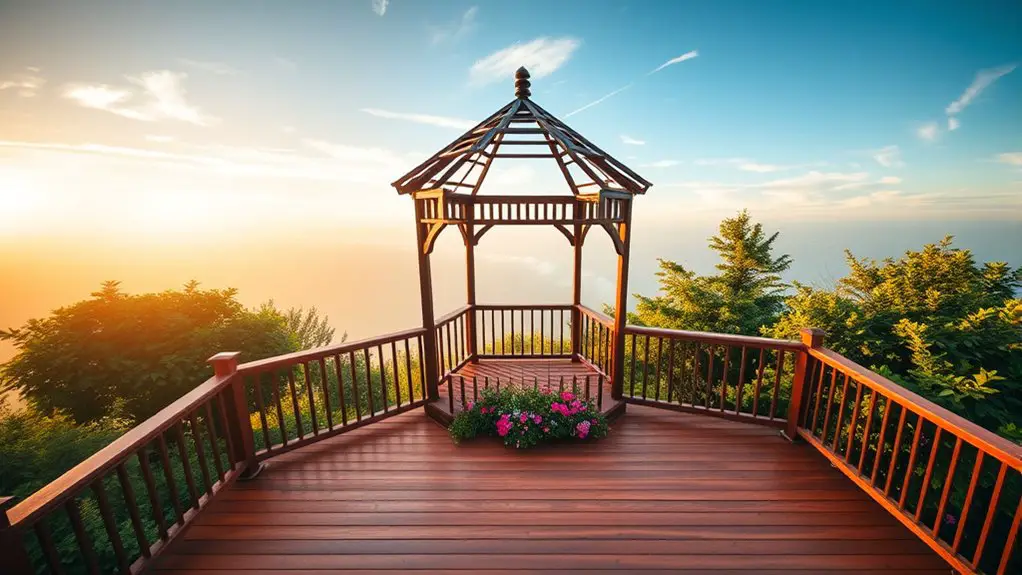To build a raised deck with a gazebo on top, start by planning your design to evaluate space and sun exposure. Gather pressure-treated lumber, decking boards, and tools like a circular saw and drill. Construct the deck frame, ensuring stability with diagonal bracing, then install deck boards with proper spacing. Next, build the gazebo using anchored posts and evenly spaced rafters. Finish with a sealant and add furniture for comfort. There’s more to perfect your project ahead.
Planning Your Design and Layout

When you’re planning your design and layout for a raised deck with a gazebo, where do you start? Begin by evaluating your space and envisioning how you want it to feel. Consider design considerations like the deck’s height, materials, and accessibility. Think about how the gazebo will integrate with your deck, providing that perfect retreat for relaxation or entertainment.
Next, explore layout options. Do you want the gazebo centered for a balanced look, or positioned to one side for a more dynamic feel? Make certain to factor in sun exposure and wind patterns to maximize comfort. Ideal placement should be on flat, sturdy ground for stability. Sketch out different configurations, experimenting with shapes and sizes that resonate with your vision of freedom in the outdoors. Remember, a well-planned layout not only enhances aesthetics but also guarantees functionality. Each decision you make sets the stage for enjoyable moments in your new outdoor sanctuary.
Gathering Materials and Tools
Gathering your materials and tools is an essential step in building a raised deck with a gazebo, and having everything ready before you start can save you time and frustration. Your choice of material types will greatly affect durability and aesthetics, while proper tool selection guarantees efficiency.
Here’s a quick reference table to help you visualize what you’ll need:
| Material Types | Tools Required |
|---|---|
| Pressure-treated wood | Circular saw |
| Decking boards | Hammer |
| Joists | Drill |
| Concrete footings | Level |
| Screws and fasteners | Tape measure |
Preparing the Site

Before you start building, it’s essential to assess the ground conditions to guarantee a stable foundation for your deck and gazebo. Look for any potential issues like uneven terrain or drainage problems, as these can affect the integrity of your structure. Once you’ve evaluated the site, carefully mark the deck layout to visualize the dimensions and positioning, setting the stage for a successful build. Additionally, ensure to check for underground utilities to avoid any hazards during excavation.
Assessing Ground Conditions
Although you might be enthusiastic to start building your raised deck and gazebo, evaluating the ground conditions is essential for ensuring a solid foundation. Begin with a thorough drainage assessment; poor drainage can undermine soil stability.
| Ground Condition | Impact on Foundation |
|---|---|
| Firm Soil | Excellent stability |
| Sandy Soil | Moderate stability |
| Clay Soil | Poor drainage risks |
| Rocky Terrain | Construction challenges |
To achieve the freedom of enjoying your deck without concerns, take the time to analyze the soil type. Check for any signs of erosion or water pooling. This groundwork will empower you to build a resilient structure that withstands the elements and enhances your outdoor haven.
Marking Deck Layout
Once you’ve assessed the ground conditions, it’s time to mark the deck layout, which is essential for an accurate build. Start by determining the deck’s dimensions and positioning, ensuring it complements your outdoor space. Grab your marking tools—string lines, stakes, and a measuring tape. First, drive stakes into the ground at your corners, then stretch the string to outline the perimeter. Confirm the layout’s squareness using the 3-4-5 triangle method. This technique guarantees right angles, ensuring a solid foundation for your deck. Don’t forget to mark any obstructions or slopes that may affect the structure. With a clear and precise deck layout, you’re one step closer to creating your dream outdoor oasis, complete with a gazebo on top.
Constructing the Raised Deck Frame
Constructing the raised deck frame is an essential step that sets the foundation for your entire project. You’ll need to guarantee the deck frame is sturdy, as it’ll support both your deck and the gazebo above. Begin by laying out your support beams, spaced appropriately to handle the weight. Here’s what to focus on:
Constructing a sturdy raised deck frame is crucial; it forms the foundation for your deck and gazebo.
- Materials: Use pressure-treated lumber for durability.
- Leveling: Check for level at each point to guarantee stability.
- Connections: Secure beams with galvanized brackets or bolts for strength.
- Bracing: Add diagonal bracing to prevent swaying and enhance support.
- Inspection: Regularly inspect for any weaknesses during construction.
Installing the Decking Boards

Now that your frame is set, it’s time to focus on the decking boards, which play an essential role in both aesthetics and functionality. You’ll need to choose the right material, making certain it fits your climate and design preferences, while also paying attention to proper spacing between boards for drainage and expansion. Finally, securing each board correctly will guarantee a sturdy, long-lasting surface that can withstand the test of time.
Choosing Decking Material
When it comes to installing decking boards, selecting the right material can make all the difference in durability and aesthetics. You’ll often find yourself choosing between composite versus wood, each offering unique benefits. Composite materials provide excellent weather resistance, while wood delivers a timeless, natural look. Consider these factors when making your decision:
- Durability: Composite resists fading and warping.
- Maintenance: Wood requires regular sealing and staining.
- Cost: Composite may have a higher upfront cost.
- Aesthetics: Wood offers a classic appeal that some prefer.
- Eco-Friendliness: Composite can be made from recycled materials.
Ultimately, weigh these options against your needs and lifestyle to find the perfect fit for your raised deck.
Proper Board Spacing
Selecting the right decking material sets the stage for a successful installation, but proper board spacing is just as essential for the longevity and performance of your raised deck. You’ll want to allow for board expansion caused by temperature fluctuations and moisture absorption. Typically, a gap of 1/8 to 1/4 inch between boards works well, ensuring they can expand without warping or buckling. This spacing also aids in moisture prevention, reducing the risk of mold and rot. Use spacers during installation to maintain consistent gaps, and remember that different materials may require adjustments in spacing. By prioritizing proper board spacing, you enhance your deck’s durability and aesthetic appeal, allowing you to enjoy your outdoor space without worry.
Securing the Boards
To secure the decking boards effectively, start by aligning each board with the previously spaced gaps. This alignment is essential for guaranteeing stability and longevity. Use secure fasteners to achieve a robust board attachment, allowing your deck to withstand the elements and everyday use.
- Choose high-quality screws or hidden fasteners for a polished look.
- Pre-drill holes to prevent cracking and enhance accuracy.
- Check for levelness as you progress to maintain a uniform surface.
- Leave adequate space for expansion, especially in humid conditions.
- Regularly inspect and tighten fasteners to maintain the deck’s integrity over time.
Building the Gazebo Structure
Building the gazebo structure requires careful planning and precise execution to guarantee stability and aesthetics. Start by evaluating your design considerations, such as the gazebo’s size, shape, and orientation. Make sure it complements your raised deck while maximizing views and natural light. For structural integrity, use pressure-treated lumber for the framework and secure it to the deck with heavy-duty brackets.
Begin with the posts, anchoring them firmly into the deck’s support beams. Next, install the rafters, making certain they’re evenly spaced to distribute weight effectively. Don’t skimp on diagonal bracing; it enhances stability against wind and other stressors. Regularly check for signs of wear or damage to ensure safety and functionality, as maintenance tips can help extend the gazebo’s lifespan.
Once the basic frame is up, you can add your roofing material, choosing something that suits both your aesthetic and practical needs. Remember, every choice you make impacts the structure’s longevity and safety, so embrace that freedom to create something truly unique!
Finishing Touches and Maintenance Tips
With the gazebo structure securely in place, it’s time to focus on the finishing touches that can elevate both its functionality and visual appeal. These details not only enhance your outdoor space but also guarantee longevity through a consistent maintenance schedule. Here are some essential finishing touches to reflect on:
- Weatherproof Sealant: Apply a high-quality sealant to protect against moisture and UV damage.
- Lighting Options: Install ambient or task lighting to create an inviting atmosphere during evening gatherings.
- Comfortable Furnishings: Choose weather-resistant furniture to encourage relaxation and enjoyment.
- Decorative Elements: Add potted plants or wall art to personalize your gazebo.
- Regular Maintenance Schedule: Establish a routine for cleaning and inspections to keep everything in top shape. Additionally, consider applying waterproofing agents to further safeguard your gazebo against moisture damage.
Frequently Asked Questions
What Permits Are Needed for Building a Raised Deck With a Gazebo?
You’ll need to check local zoning regulations and building codes before starting your project. Permits often include structural, electrical, and possibly aesthetic considerations, ensuring your raised deck and gazebo comply with safety and community standards.
How Long Does It Take to Build a Raised Deck and Gazebo?
Building a raised deck and gazebo typically takes several weeks, depending on your construction timeline and project challenges. Weather, materials, and skill level can all impact the time required, so plan accordingly for freedom in your project.
Can I Add Electrical Outlets to My Gazebo?
You can absolutely add electrical outlets to your gazebo, but consider outlet placement carefully. Prioritize electrical safety; guarantee you use weatherproof covers and consult a professional if you’re unsure about the installation process. Enjoy your freedom!
What Are the Best Materials for a Low-Maintenance Deck?
For a low-maintenance deck, consider composite decking for durability and easy upkeep. Pair it with PVC railing to enhance aesthetics while resisting weathering. You’ll enjoy more freedom to relax without constant maintenance worries.
How Do I Insure My Raised Deck and Gazebo?
Did you know 60% of homeowners overlook insurance for outdoor structures? When considering deck insurance options, address gazebo coverage concerns by consulting your insurer to guarantee both structures are adequately protected against potential damages and liabilities.

